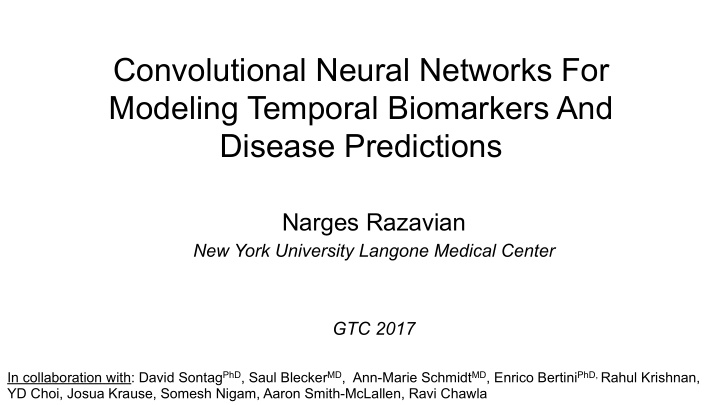



Convolutional Neural Networks For Modeling Temporal Biomarkers And Disease Predictions Narges Razavian New York University Langone Medical Center GTC 2017 In collaboration with: David Sontag PhD , Saul Blecker MD , Ann-Marie Schmidt MD , Enrico Bertini PhD, Rahul Krishnan, YD Choi, Josua Krause, Somesh Nigam, Aaron Smith-McLallen, Ravi Chawla
Parallel Developments Error rate on Image-Net object EHR adoption by healthcare recognition challenge centers in the US Deep learning progress Healthcare world getting digital
What is captured in the EHR? Source: healthcare.gov
Healthcare has joined the data-rich world
Moving from Treatment to Prevention Challenges: Each Individual has a different ‘healthy’ baseline. - Temporal Patterns/Trends are predictive Each biomarker varies at a different speed in our bodies Measurements are sparse, asynchronous and correlated Many correlated outcomes are observed per patient - Can we leverage this correlation?
Biomarkers and Outcomes Biomarkers measurements over time
Biomarkers and Outcomes Biomarkers measurements over time Phenotype (diseases) over time
Biomarkers and Outcomes Biomarkers measurements over time Phenotype (diseases) over time
Biomarkers and Outcomes Biomarkers measurements over time Phenotype (diseases) over time
Step 1 Learn each biomarker from other biomarkers time-series
Kernel Regression Observations (Measurement Time-Series) X Time Not Observed Want to estimate
Kernel Regression ∫ E [ X ( v )] = xP ( x | t = v , X train ) dx Observations (Measurement P ( x , t = v | Xtrain ) Time-Series) ∫ E [ X | t = v , X train ] = x P ( t = v | Xtrain ) dx X ∑ K ( x − x i , v − t i ) x i , t i ∫ E [ X | t = v , X train ] = x dx ∑ K ( v − t i ) Time t i Not Observed Want to estimate
Kernel Regression ∫ E [ X ( v )] = xP ( x | t = v , X train ) dx Observations (Measurement P ( x , t = v | Xtrain ) Time-Series) ∫ E [ X | t = v , X train ] = x P ( t = v | Xtrain ) dx X ∑ K ( x − x i , v − t i ) x i , t i ∫ E [ X | t = v , X train ] = x dx ∑ K ( v − t i ) Time t i Not Observed Want to estimate ( K ⊗ X train )( v ) E [ X | t = v , X train ] = ( K ⊗ I ( X train : Observed ))( v )
Use convolution framework to LEARN those kernels
Benefits We can learn the kernel (No need for parametric forms and cross validations) Easily extendible to multivariate! Unsupervised: All needed is (asynchronous) sequence of observations. Fast to train. Fast to apply.
Mul$variate Kernels learned for each input dimension (total 18) Data: 30K Individuals from the original training set. Dataset split equally between train, test and validate set. Loss: MSE. Train and evaluate only on (lab, person) with more than 1 observaGon.
More details in our ICLR paper Narges Razavian, David Sontag Temporal Convolutional Neural Networks for Diagnosis from Lab Tests http://arxiv.org/abs/1511.07938 Open Source code available (torch/lua implementation): https://github.com/clinicalml/deepDiagnosis
Step 2 Predict 200+ correlated outcomes using multi- resolution convolutional neural networks and multi-task learning
Multi-Resolution Convolution Networks The Architecture - model (1)
Multi-Resolution Convolution Networks The Architecture - model (2)
Prediction AUCs on the held-out test set
More details in our JMLR paper Narges Razavian, Jake Marcus, David Sontag, Multi-task Prediction of Disease Onsets from Longitudinal Lab Tests JMLR, 2016 http://arxiv.org/abs/1608.00647 Open Source code available (torch/lua implementation): https://github.com/clinicalml/deepDiagnosis
Following up in clinical world • Prediction models built and deployed for – Nurse calls and home visits for 250,000+ NYUMC patients at high risk for a number of these outcomes – Improved documentation in EHR • Automation of mandatory visits/screening/follow-ups • Best practice alerts • Reimbursement for intense lifestyle management programs • Extending to broader outcomes and domains
New York University (i2b2) Database
New York University (i2b2) Database Nuclear Medicine Procedures Magnetic Resonance Imaging
Conclusions • Applications of deep learning in healthcare are unlimited • Unsupervised learning + back-propagation + deep learning can recover biomarker models from asynchronous high- dimensional time-series data • Multi-task learning benefits prediction tasks with smaller datasets.
Thanks! Questions/comments: Narges.Razavian@nyumc.org Open Source Package: https://github.com/clinicalml/deepDiagnosis
Recommend
More recommend